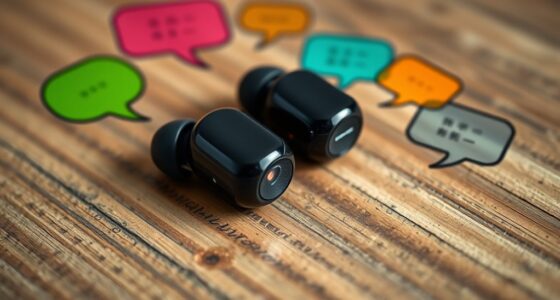Choosing between a smart ring and a smartwatch depends on your lifestyle and preferences. If you want discreet, comfortable wear for sleep and minimal interference, a smart ring offers long-lasting battery life and subtle health tracking. If you prefer more features, like GPS, notifications, and detailed fitness data, a smartwatch is better. Understanding their differences helps you pick the device that fits your daily routine. Explore further to find the perfect fit for your needs.
Key Takeaways
- Smart rings offer discreet, comfortable wear ideal for sleep tracking and minimal interference, while smartwatches provide extensive features for active users.
- For health monitoring, smart rings deliver more accurate heart rate and sleep data, whereas smartwatches excel with GPS and workout tracking.
- Smart rings have longer battery life and are less obtrusive; smartwatches require daily charging and are more noticeable on the wrist.
- Choose a smart ring if you prefer subtlety, comfort, and longer wear; opt for a smartwatch if you need detailed fitness, navigation, and communication features.
- Consider your lifestyle and priorities—discreet health tracking versus multifunctionality—when deciding between the two devices.
Design and Wearability Differences

When comparing the design and wearability of smart rings and smartwatches, the key difference lies in their size and form factor. Smart rings are much smaller, worn on your finger, and weigh just 2–4 grams, making them discreet jewelry pieces. In contrast, smartwatches are bulkier, weighing 40–80 grams, with larger displays that resemble traditional watches but can be less subtle. Smart rings are lightweight and unobtrusive, comfortable enough for continuous wear, even during sleep. The design of smart rings is sleek and minimal, often in classic jewelry colors, while smartwatches offer diverse styles, from sporty to luxury. Finger placement ensures sensor contact, but sizing can be tricky due to finger swelling. Additionally, the subtlety of smart rings allows for more discreet health monitoring compared to the more prominent presence of smartwatches. As technology advances, some smart rings now incorporate advanced sensors, enhancing their functionality without compromising their discreet design. This progress has made smart rings more versatile and reliable, especially with improvements in sensor technology, making them suitable for various health and activity tracking needs. Moreover, the wearability of these devices depends on individual comfort preferences and lifestyle needs, influencing user choice.
Core Functionalities and Features
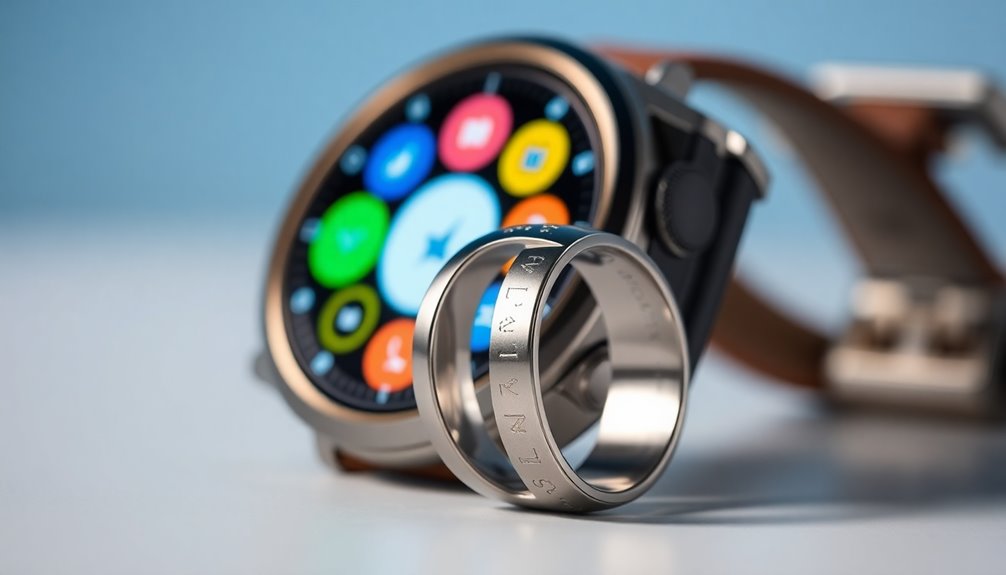
Smartwatches and smart rings differ markedly in their core functionalities, particularly regarding communication and notifications. With a built-in display, smartwatches let you view and respond to calls, messages, and alerts directly on your wrist. Some LTE-enabled models even operate independently of your phone for calls, messaging, and emergency SOS. In contrast, smart rings lack screens and controls, relying on paired smartphones to read and manage notifications. Both devices increasingly support NFC for contactless payments, though availability varies. Voice assistants are integrated into some smartwatches, like Siri on the Apple Watch Series 9, while certain smart rings include assistants like Kira Plus. Overall, smartwatches offer more direct interaction, whereas smart rings depend on their smartphone companions for communication features. Additionally, the presence of advanced display technology in smartwatches enhances user experience by providing detailed visual feedback. Moreover, smartwatches utilize specific hardware components to enable features like heart rate monitoring and fitness tracking, making them versatile wearable devices.
Precision in Health and Fitness Data
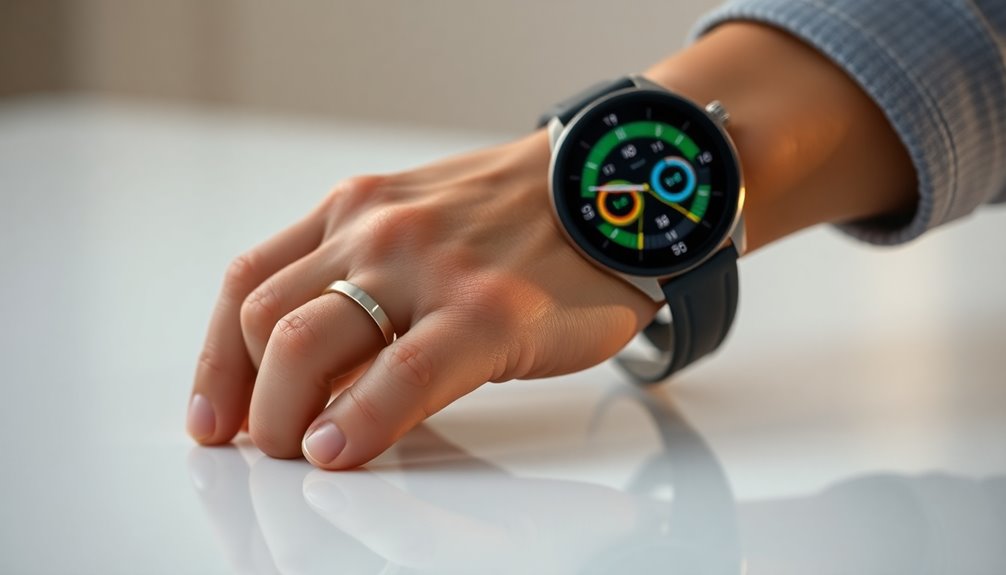
Smart rings often provide more consistent and accurate health and fitness data compared to wrist-worn devices, thanks to their placement on the finger. Because they use photoplethysmography (PPG) sensors on the finger, they benefit from better blood vessel proximity and less motion artifact, leading to more reliable heart rate readings, especially at low to moderate intensities. However, accuracy can decline during intense exercise or if the fit is poor. For step counting, smart rings tend to be less precise, often overestimating during non-walking activities or underestimating during actual exercise. Sleep tracking with smart rings is highly accurate, thanks to better sensor contact and stable biometric monitoring. But, since they lack built-in GPS, outdoor workout tracking depends on a paired smartphone, limiting precision in location-based metrics. As automation continues to advance in health devices, data privacy concerns become increasingly important to address. Additionally, ongoing improvements in sensor technology and software algorithms are expected to enhance the overall accuracy and reliability of smart rings in the future.
Battery Life and Maintenance Needs
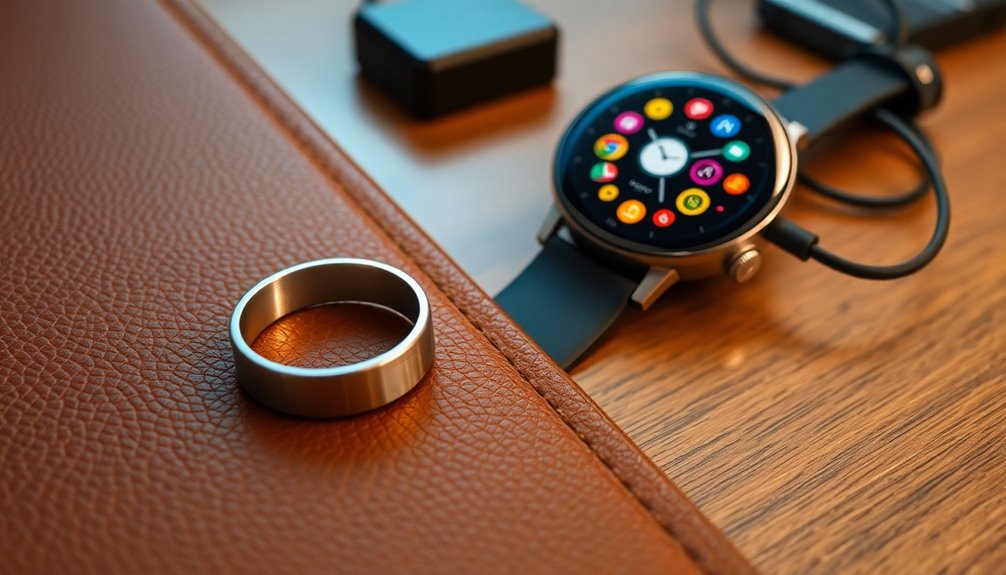
Battery life varies considerably between smart rings and smartwatches, impacting how often you’ll need to charge them. Smart rings like the Oura Ring 4 typically last several days to over a week, but they usually need charging every few days, with a full charge taking 20-80 minutes. Recent models such as the RingConn Gen 2 can last up to 12 days, offering more convenience. In contrast, smartwatches often require daily charging due to their larger displays and advanced features. Proper maintenance, like using original chargers, avoiding extreme temperatures, and unplugging once fully charged, can extend your device’s battery life. Regular firmware updates also help optimize performance. Overall, smart rings tend to offer longer-lasting batteries with less frequent charging needs, making them more low-maintenance. Additionally, advancements in AI-driven security systems are helping to protect these devices from potential threats. To maximize battery longevity, it’s also beneficial to manage power settings and disable unused features when possible. Incorporating smart charging habits, such as avoiding overcharging, can further preserve battery health over time. Maintaining good battery health practices can significantly contribute to extending the overall lifespan of your device’s battery.
Cost and Investment Considerations
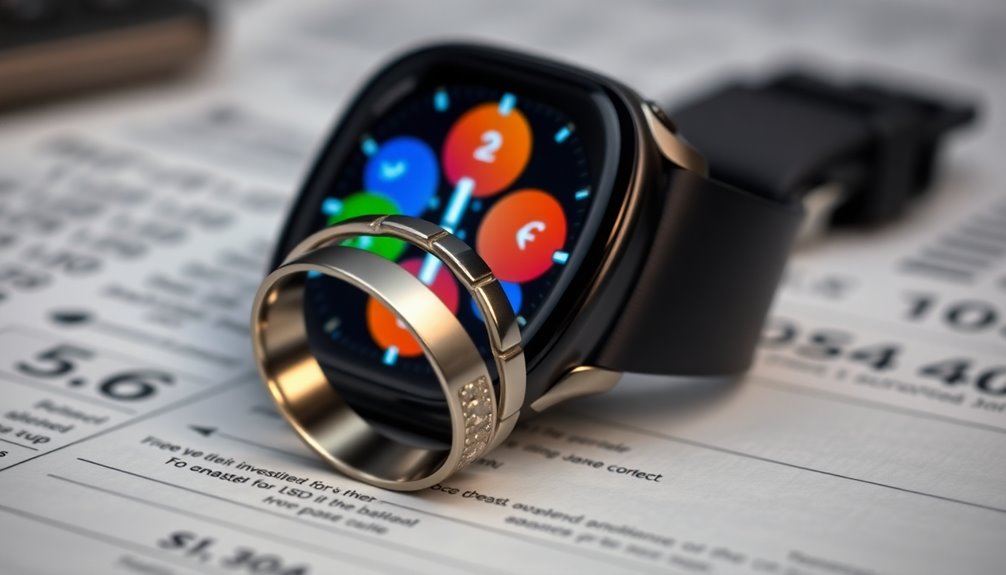
When evaluating the cost and investment potential of wearable devices, smart rings typically range from $250 to $400 upfront, with some models requiring additional subscription fees for advanced features. Subscription-based rings like the Oura Ring add around $6 monthly, increasing the overall cost over time. In contrast, subscription-free smart rings offer better long-term value by avoiding recurring fees and storing data locally, which enhances privacy. Smartwatches, especially flagship models, often fall within a similar price range but generally provide more features. Keep in mind that some smart rings offer data subscriptions to justify higher initial costs, making the total investment depend on your preferred features and privacy preferences. Over time, smart rings can be a cost-effective choice if you prioritize health tracking without ongoing payments. Additionally, understanding sound healing science and the benefits of integrating calming technologies can enhance your overall health benefits from wearable devices, especially when considering biofeedback features that promote relaxation and mental wellness. Incorporating privacy-focused design into your device selection can also help safeguard your personal data while enjoying these health benefits. Considering the durability and battery life of these devices can further influence your long-term satisfaction and investment value, especially since some models are designed with water resistance to withstand daily use.
Ideal User Profiles and Use Cases
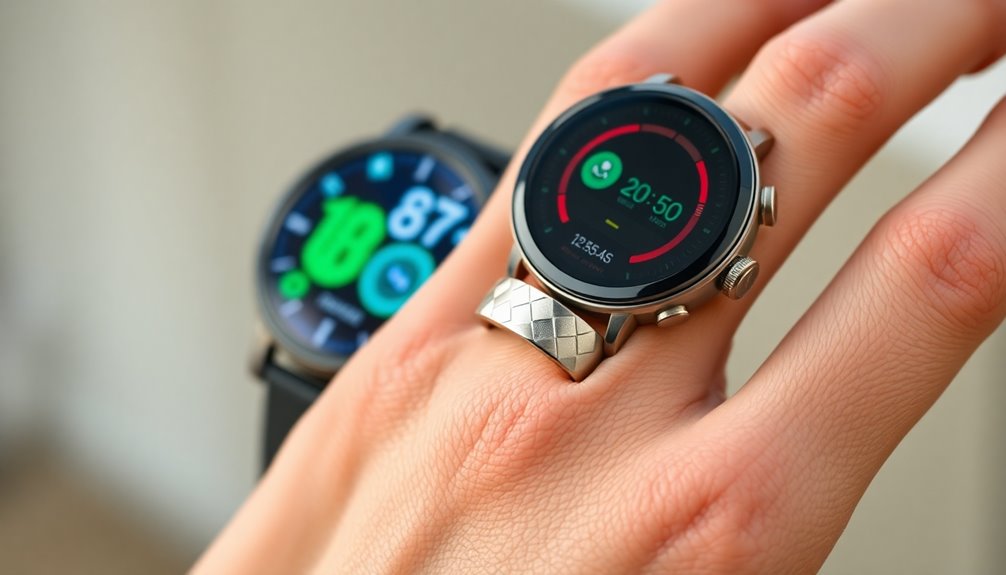
Choosing between a smart ring and a smartwatch depends on your lifestyle and priorities. If you’re focused on health metrics like sleep and heart rate, a smart ring offers discreet, comfortable tracking without distraction. It’s ideal for casual users who prefer minimalism and sleep comfort. On the other hand, if you’re into detailed fitness data, GPS, and app integration, a smartwatch suits active individuals and tech enthusiasts. Travelers benefit from its navigation and app management. For daily convenience, smartwatches excel with notifications, music control, and mobile payments. Fitness enthusiasts seeking precise workout tracking and location data will find smartwatches more suitable. Meanwhile, smart rings work well for those wanting consistent health monitoring and a subtle device that fits seamlessly into everyday life. Additionally, the effectiveness and safety of these devices is important to consider when making your choice. Ensuring proper device maintenance can extend the lifespan and performance of your device. Understanding the copyright and trademark differences can also influence how you personalize and protect your device accessories if you develop custom items. It’s also beneficial to evaluate the compatibility and ecosystem of these devices with your existing technology to ensure seamless integration. Proper user training and education can maximize the benefits and ensure safe, effective use of your chosen device.
Advantages of Combining Both Devices

Combining a smart ring and a smartwatch creates a powerful synergy that enhances your overall health monitoring and device usability. The ring provides precise, passive tracking of heart rate variability, sleep stages, and oxygen saturation with minimal disturbance, while the watch offers broader metrics like GPS activity tracking and on-demand heart rate checks. Together, they deliver extensive data—long-term, passive insights from the ring alongside active, contextual fitness information from the watch—improving accuracy and wellbeing management. The ring’s long battery life ensures continuous overnight monitoring, even when the watch needs charging. This pairing also balances discreetness and convenience: the ring stays subtle and comfortable, while the watch provides quick notifications and interaction. Overall, combining both devices gives you a versatile, efficient way to stay connected to your health.
Limitations and Challenges of Each

While pairing a smart ring with a smartwatch offers many benefits, each device has its own set of limitations that can impact your experience. Smart rings lack displays, so you rely on companion apps for updates, which isn’t ideal during workouts or quick checks. They also struggle to accurately track complex exercises like weightlifting or high-intensity intervals. Sizing can be tricky, requiring precise fit for accurate sensors, and durability is a concern since fingers face water, sweat, and physical wear. Security vulnerabilities are another issue, as limited processing power can leave data exposed. Smartwatches, on the other hand, often need frequent charging, can be bulky, and may distract you with notifications. They tend to be less accurate during intense activity and come at a higher cost, making both devices imperfect for certain needs.
Making the Right Choice for Your Lifestyle

Selecting the right wearable depends on your lifestyle and what features matter most to you. If you prefer a discreet, stylish device that’s comfortable for all-day wear and sleep, a smart ring might suit you best. It offers a minimalist design, longer battery life, and accurate heart rate or sleep tracking. On the other hand, if you’re active, tech-savvy, or want more customization, a smartwatch provides versatile features like GPS, music, mobile payments, and extensive app integration. Smartwatches are more durable and better suited for intense workouts, while rings excel in subtlety and comfort. Consider your daily routines, fitness goals, and style preferences. Choosing the device that aligns with your habits ensures you get the most out of your wearable, making it a seamless part of your life.
Frequently Asked Questions
Can Smart Rings and Smartwatches Be Used Together Effectively?
Yes, you can use smart rings and smartwatches together effectively. They complement each other by offering detailed sleep, recovery, and physiological data from the ring, while the watch handles notifications, GPS, and active workouts. Just make certain they sync with compatible apps or ecosystems, so your data stays unified. Wearing both provides a thorough view of your health without sacrificing convenience or style, making your fitness tracking more accurate and seamless.
Are There Specific Health Metrics That Only Smart Rings or Only Smartwatches Can Track?
You want to know which health metrics are unique to each device. Smart rings excel in continuous skin temperature monitoring, early illness detection, and discreet, long-term wear, making them ideal for tracking subtle biometric changes. On the other hand, smartwatches offer ECG readings, blood oxygen levels, GPS-based activity tracking, and fall detection, providing more advanced cardiac diagnostics and exercise data that smart rings typically can’t deliver.
How Do Smart Rings Handle Notifications Compared to Smartwatches?
Imagine missing an important message in a sea of notifications—smart rings keep your world discreet, vibrating gently to alert you. Unlike smartwatches with vivid displays and instant responses, smart rings rely on subtle vibrations and companion apps for details. You won’t see or hear alerts directly, but you’ll feel them. This minimal approach prioritizes privacy and battery life, perfect if you prefer a quiet, unobtrusive way to stay connected.
What Are the Privacy Implications of Using Smart Rings Versus Smartwatches?
When considering privacy, smart rings and smartwatches both gather sensitive health data, but smart rings often have less extensive data storage, potentially reducing risk. However, they might lack robust authentication, making them vulnerable. Smartwatches usually offer stronger security features like fingerprint access and encrypted data, but support third-party apps and location tracking, which can increase privacy concerns. You should weigh security measures and data handling practices before choosing.
Which Device Is Better for Users With Sensitive Skin or Allergies?
Oh, the irony! You wanna avoid skin irritation, yet choose a bulky device that might cause more trouble? Smart rings are your best bet—they’re sleek, lightweight, and made with hypoallergenic materials, perfect for sensitive skin. Smartwatches, on the other hand, can irritate due to their size, materials, and constant wear. So, if you want comfort without the allergy drama, go for the smart ring and keep irritation at bay.
Conclusion
Choosing between a smart ring and a smartwatch is like selecting your sword or shield—each has its strengths. Think about your daily battles: style, health tracking, or convenience. Remember, the right device adapts to your lifestyle, just as a knight chooses armor suited for the quest. By weighing their unique powers, you’ll find the perfect match to support your journey toward a healthier, more connected life. The choice is yours—embrace it wisely.


